Second in the series of Environmental Landscape journals I wrote for class.
10/13/05 -- CENTURY CITY, CA
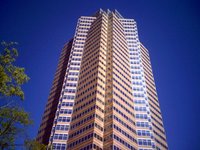
I am on a mission from God. Okay, not God exactly. My good friend, who is working on a project for Disney, needs me to drop something off at the Fox television clip library, which is housed on the Lot. I get to leave the high-rise where I work -- Fox Plaza, otherwise known in the movies as "Nakatomi Plaza" (from the movie "Die Hard" which was shot here). The reason for my joy is two-fold. One, I get to take a walk in the open air (away from a buidling where the windows don't open and the climate control is always off), and see some "outside"; and, two, because Thursday is sushi day at the Fox Commissary.
The Fox TV clip library is housed on one of the only parts of the 20th Century Fox lot that was part of the original studio, before it was sold off and developed in the early 70s by that ratbastard Marvin Davis (I'm sorry -- that just slipped out). It's my favorite part of the studio, because there's lots of history here. The old dressing room bungalows have been converted to production offices, and the two "Writers Buildings" (old and new) now serve to hold the staple production companies (David E. Kelley, Matt Groening) that make the shows that are currently keeping the studio afloat. (Nature lesson #1 -- The one who gathers the most resources at his disposal gets the choicest real estate.)
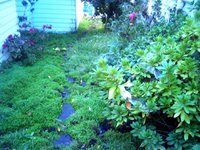 On my way out of the Old Writers' Building, where the clip library is stashed, I see two of the Fox's finest. No, not the security guards. I mean the Lot cats. Almost all backlots, from Paramount to Disney, are full of feral cats that have been abandoned or have made their way there. They're speedy little devils, though, and before I can capture them on my camera phone, they've ducked under the little wildernesses that someone has planted between the production bungalows. The Fox cats have one single job on the lot -- they are the rat police. A couple of studios have tried to rid themselves of the inconvenient cat population, only to reinstate it later when they discovered that with the absence of the cats came the large, unchallenged daring rodents. Now most studios institute a "neuter-and-release" program, whereby the cats are not allowed to breed out of control, but are allowed to continue unmolested as they do their thing. (Nature lesson #2: In the presence of a balanced eco-system, introducing a man-made disturbance regime is often ill-advised and always tedious to rectify.)
On my way out of the Old Writers' Building, where the clip library is stashed, I see two of the Fox's finest. No, not the security guards. I mean the Lot cats. Almost all backlots, from Paramount to Disney, are full of feral cats that have been abandoned or have made their way there. They're speedy little devils, though, and before I can capture them on my camera phone, they've ducked under the little wildernesses that someone has planted between the production bungalows. The Fox cats have one single job on the lot -- they are the rat police. A couple of studios have tried to rid themselves of the inconvenient cat population, only to reinstate it later when they discovered that with the absence of the cats came the large, unchallenged daring rodents. Now most studios institute a "neuter-and-release" program, whereby the cats are not allowed to breed out of control, but are allowed to continue unmolested as they do their thing. (Nature lesson #2: In the presence of a balanced eco-system, introducing a man-made disturbance regime is often ill-advised and always tedious to rectify.)
In front of the New Writers' Building, where the writers for The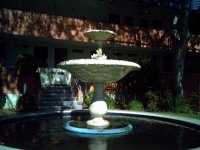 Simpsons and Family Guy hang out (clearly a disturbed bunch), there is an old fountain that has not worked correctly since the first time I visited the lot in the early '80s. The trickle of water, which is intended to flow from the top, then down all sides of the two-tiered structure, and into the pool below, has been rendered ridiculous with a single trickle down the right-hand side. The only thing that makes the fountain even remotely useful, other than as a nostalgic conversation piece, is that some impetuous fool has stocked the fountain with koi fish. This was not a Fox executive decision, I'm sure. Fox studio executives don't
Simpsons and Family Guy hang out (clearly a disturbed bunch), there is an old fountain that has not worked correctly since the first time I visited the lot in the early '80s. The trickle of water, which is intended to flow from the top, then down all sides of the two-tiered structure, and into the pool below, has been rendered ridiculous with a single trickle down the right-hand side. The only thing that makes the fountain even remotely useful, other than as a nostalgic conversation piece, is that some impetuous fool has stocked the fountain with koi fish. This was not a Fox executive decision, I'm sure. Fox studio executives don't 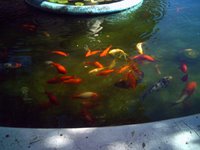 tend to make decisions that create artful little patches of nature anywhere. Still, the fish are pretty happy here (at least, they seem to be -- with fish, who can tell?), and the odd circumstance of their enclosure has not seemed to dampened their appetites. As I walk around the fountain, they follow me, gathering in a school at the fountain's edge, jawing the water, waiting for me to feed them. (Nature lesson #3: Life can pretty much happen anywhere it's given a foot in the door; and Nature lesson #4: Being chased and stalked by rapacious koi fish is weird and creepy.)
tend to make decisions that create artful little patches of nature anywhere. Still, the fish are pretty happy here (at least, they seem to be -- with fish, who can tell?), and the odd circumstance of their enclosure has not seemed to dampened their appetites. As I walk around the fountain, they follow me, gathering in a school at the fountain's edge, jawing the water, waiting for me to feed them. (Nature lesson #3: Life can pretty much happen anywhere it's given a foot in the door; and Nature lesson #4: Being chased and stalked by rapacious koi fish is weird and creepy.)
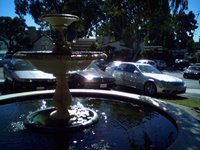
From a slightly different angle, it appears that the fountain has actually become a watering hole for expensive motor vehicles. There's a metaphor here somewhere, but the whole koi fish episode has kind of creeped me out and I can't find it save my life. You're welcome to take a whack at it. (Nature Lesson #5: see Nature Lesson #7).
Fox doesn't tend to like "accidental nature" too much (I refer you back to the paragraph on feral cats). Fox likes its nature planned, coordinated, architected, drawn and then brought in on flatbed trucks. Nowhere was this more evident when Rupert Murdoch's wife… make that Rupert Murdoch's former wife (not to be confused with the sweet young thing that currently holds that particular distinction) -- decided that Fox needed a bit of gussying up. In her defense, she couldn't have been more right. Ten years ago, we who had once worked at Paramount (arguably the most architecturely beautiful and still intact studio remaining to date) referred to Fox as "Tobacco Road." Trailers abounded, there was nothing even remotely resembling a landscape design, and even the Executive Building, where the chief-high-muckity-mucks worked, smelled something like a stable on a hot July day.
 Anna Murdoch set about to create one little patch of civility in the midst of disaster. Thus was born "The Walk." Extending from Studio 20 (where Reba is filmed) down to the Commissary and Studio Store, it was designed as place employees could gather during lunch breaks, sit, eat, read and/or relax. Note the neatly trimmed lawns, the curbed plant beds, the carefully trimmed and maintained trees (ignore that high-rise in the background -- that's the MGM Building on Constellation. Big weinies. We hate them.) Anna left no stone unturned. Or did she?
Anna Murdoch set about to create one little patch of civility in the midst of disaster. Thus was born "The Walk." Extending from Studio 20 (where Reba is filmed) down to the Commissary and Studio Store, it was designed as place employees could gather during lunch breaks, sit, eat, read and/or relax. Note the neatly trimmed lawns, the curbed plant beds, the carefully trimmed and maintained trees (ignore that high-rise in the background -- that's the MGM Building on Constellation. Big weinies. We hate them.) Anna left no stone unturned. Or did she?
Back in the olden days, when I was still chubby and Anna Murdoch was still the au current Mrs. Murdoch, my job then necessitated several trips from the Plaza to the Lot everyday. I was getting more nature than I knew what to do with back then; I just didn't know it. The day that construction of The Walk got interesting was the day they brought in some nature -- carefully sandblasted, cut to order, sanitized for our protection -- as, of course, all nature should be.

There are four such little seating areas along The Walk, all of them carefully delineated by these boulders, carefully placed so as to look as if some landslide had simply deposited them there by chance. It takes a lot of effort to make nature look so random. Just ask the crew of four flatbed trucks, two Bobcat dozers, and twelve workmen, all slaving away to place the boulders to the "just-so" specifications of Anna Murdoch and her landscape architect.
This is how Fox likes its nature. Nature here needs to be carved or trimmed or otherwise created in a controlled way, lest it break out of its designated borders and run roughshod all over the place. (Nature lesson #6: Nature must never be left to its own anarchic devices because its sneaky and if given an inch will take a mile.)
The Walk ends at the Fox Commissary, and today is (as I've mentioned) sushi day. But before we go in and secure our stash of cold, dead fish, let us take one last look at nature the way it was before we ever got here.
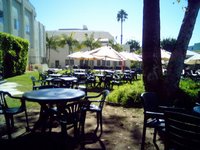 Behold, a group of plastic patio tables, gathered for a late morning graze. Huge herds of these noble beasts used to roam unmolested over the vast open prairie land of what is now Century City, Westwood and West Los Angeles, before the white man came and drove them to near-extinction with their incessant BBQs and weinie roasts. Now, only scattered small clusters remain to remind us of a time in our history before movie studios, trophy wives, multinational corporate moguls, feral cats and imported boulders shaped our environment. (Nature lesson #7: Anything can look like nature if viewed from the proper angle.)
Behold, a group of plastic patio tables, gathered for a late morning graze. Huge herds of these noble beasts used to roam unmolested over the vast open prairie land of what is now Century City, Westwood and West Los Angeles, before the white man came and drove them to near-extinction with their incessant BBQs and weinie roasts. Now, only scattered small clusters remain to remind us of a time in our history before movie studios, trophy wives, multinational corporate moguls, feral cats and imported boulders shaped our environment. (Nature lesson #7: Anything can look like nature if viewed from the proper angle.)
Okay… I'm done…. Clearly, I need protein. I have a date with some cold, dead fish. At least these guys know their place -- they stay put in the tray and don't follow me around, like those damn koi fish.

I am on a mission from God. Okay, not God exactly. My good friend, who is working on a project for Disney, needs me to drop something off at the Fox television clip library, which is housed on the Lot. I get to leave the high-rise where I work -- Fox Plaza, otherwise known in the movies as "Nakatomi Plaza" (from the movie "Die Hard" which was shot here). The reason for my joy is two-fold. One, I get to take a walk in the open air (away from a buidling where the windows don't open and the climate control is always off), and see some "outside"; and, two, because Thursday is sushi day at the Fox Commissary.
The Fox TV clip library is housed on one of the only parts of the 20th Century Fox lot that was part of the original studio, before it was sold off and developed in the early 70s by that ratbastard Marvin Davis (I'm sorry -- that just slipped out). It's my favorite part of the studio, because there's lots of history here. The old dressing room bungalows have been converted to production offices, and the two "Writers Buildings" (old and new) now serve to hold the staple production companies (David E. Kelley, Matt Groening) that make the shows that are currently keeping the studio afloat. (Nature lesson #1 -- The one who gathers the most resources at his disposal gets the choicest real estate.)
 On my way out of the Old Writers' Building, where the clip library is stashed, I see two of the Fox's finest. No, not the security guards. I mean the Lot cats. Almost all backlots, from Paramount to Disney, are full of feral cats that have been abandoned or have made their way there. They're speedy little devils, though, and before I can capture them on my camera phone, they've ducked under the little wildernesses that someone has planted between the production bungalows. The Fox cats have one single job on the lot -- they are the rat police. A couple of studios have tried to rid themselves of the inconvenient cat population, only to reinstate it later when they discovered that with the absence of the cats came the large, unchallenged daring rodents. Now most studios institute a "neuter-and-release" program, whereby the cats are not allowed to breed out of control, but are allowed to continue unmolested as they do their thing. (Nature lesson #2: In the presence of a balanced eco-system, introducing a man-made disturbance regime is often ill-advised and always tedious to rectify.)
On my way out of the Old Writers' Building, where the clip library is stashed, I see two of the Fox's finest. No, not the security guards. I mean the Lot cats. Almost all backlots, from Paramount to Disney, are full of feral cats that have been abandoned or have made their way there. They're speedy little devils, though, and before I can capture them on my camera phone, they've ducked under the little wildernesses that someone has planted between the production bungalows. The Fox cats have one single job on the lot -- they are the rat police. A couple of studios have tried to rid themselves of the inconvenient cat population, only to reinstate it later when they discovered that with the absence of the cats came the large, unchallenged daring rodents. Now most studios institute a "neuter-and-release" program, whereby the cats are not allowed to breed out of control, but are allowed to continue unmolested as they do their thing. (Nature lesson #2: In the presence of a balanced eco-system, introducing a man-made disturbance regime is often ill-advised and always tedious to rectify.)In front of the New Writers' Building, where the writers for The
 Simpsons and Family Guy hang out (clearly a disturbed bunch), there is an old fountain that has not worked correctly since the first time I visited the lot in the early '80s. The trickle of water, which is intended to flow from the top, then down all sides of the two-tiered structure, and into the pool below, has been rendered ridiculous with a single trickle down the right-hand side. The only thing that makes the fountain even remotely useful, other than as a nostalgic conversation piece, is that some impetuous fool has stocked the fountain with koi fish. This was not a Fox executive decision, I'm sure. Fox studio executives don't
Simpsons and Family Guy hang out (clearly a disturbed bunch), there is an old fountain that has not worked correctly since the first time I visited the lot in the early '80s. The trickle of water, which is intended to flow from the top, then down all sides of the two-tiered structure, and into the pool below, has been rendered ridiculous with a single trickle down the right-hand side. The only thing that makes the fountain even remotely useful, other than as a nostalgic conversation piece, is that some impetuous fool has stocked the fountain with koi fish. This was not a Fox executive decision, I'm sure. Fox studio executives don't  tend to make decisions that create artful little patches of nature anywhere. Still, the fish are pretty happy here (at least, they seem to be -- with fish, who can tell?), and the odd circumstance of their enclosure has not seemed to dampened their appetites. As I walk around the fountain, they follow me, gathering in a school at the fountain's edge, jawing the water, waiting for me to feed them. (Nature lesson #3: Life can pretty much happen anywhere it's given a foot in the door; and Nature lesson #4: Being chased and stalked by rapacious koi fish is weird and creepy.)
tend to make decisions that create artful little patches of nature anywhere. Still, the fish are pretty happy here (at least, they seem to be -- with fish, who can tell?), and the odd circumstance of their enclosure has not seemed to dampened their appetites. As I walk around the fountain, they follow me, gathering in a school at the fountain's edge, jawing the water, waiting for me to feed them. (Nature lesson #3: Life can pretty much happen anywhere it's given a foot in the door; and Nature lesson #4: Being chased and stalked by rapacious koi fish is weird and creepy.)
From a slightly different angle, it appears that the fountain has actually become a watering hole for expensive motor vehicles. There's a metaphor here somewhere, but the whole koi fish episode has kind of creeped me out and I can't find it save my life. You're welcome to take a whack at it. (Nature Lesson #5: see Nature Lesson #7).
Fox doesn't tend to like "accidental nature" too much (I refer you back to the paragraph on feral cats). Fox likes its nature planned, coordinated, architected, drawn and then brought in on flatbed trucks. Nowhere was this more evident when Rupert Murdoch's wife… make that Rupert Murdoch's former wife (not to be confused with the sweet young thing that currently holds that particular distinction) -- decided that Fox needed a bit of gussying up. In her defense, she couldn't have been more right. Ten years ago, we who had once worked at Paramount (arguably the most architecturely beautiful and still intact studio remaining to date) referred to Fox as "Tobacco Road." Trailers abounded, there was nothing even remotely resembling a landscape design, and even the Executive Building, where the chief-high-muckity-mucks worked, smelled something like a stable on a hot July day.
 Anna Murdoch set about to create one little patch of civility in the midst of disaster. Thus was born "The Walk." Extending from Studio 20 (where Reba is filmed) down to the Commissary and Studio Store, it was designed as place employees could gather during lunch breaks, sit, eat, read and/or relax. Note the neatly trimmed lawns, the curbed plant beds, the carefully trimmed and maintained trees (ignore that high-rise in the background -- that's the MGM Building on Constellation. Big weinies. We hate them.) Anna left no stone unturned. Or did she?
Anna Murdoch set about to create one little patch of civility in the midst of disaster. Thus was born "The Walk." Extending from Studio 20 (where Reba is filmed) down to the Commissary and Studio Store, it was designed as place employees could gather during lunch breaks, sit, eat, read and/or relax. Note the neatly trimmed lawns, the curbed plant beds, the carefully trimmed and maintained trees (ignore that high-rise in the background -- that's the MGM Building on Constellation. Big weinies. We hate them.) Anna left no stone unturned. Or did she?Back in the olden days, when I was still chubby and Anna Murdoch was still the au current Mrs. Murdoch, my job then necessitated several trips from the Plaza to the Lot everyday. I was getting more nature than I knew what to do with back then; I just didn't know it. The day that construction of The Walk got interesting was the day they brought in some nature -- carefully sandblasted, cut to order, sanitized for our protection -- as, of course, all nature should be.

There are four such little seating areas along The Walk, all of them carefully delineated by these boulders, carefully placed so as to look as if some landslide had simply deposited them there by chance. It takes a lot of effort to make nature look so random. Just ask the crew of four flatbed trucks, two Bobcat dozers, and twelve workmen, all slaving away to place the boulders to the "just-so" specifications of Anna Murdoch and her landscape architect.
This is how Fox likes its nature. Nature here needs to be carved or trimmed or otherwise created in a controlled way, lest it break out of its designated borders and run roughshod all over the place. (Nature lesson #6: Nature must never be left to its own anarchic devices because its sneaky and if given an inch will take a mile.)
The Walk ends at the Fox Commissary, and today is (as I've mentioned) sushi day. But before we go in and secure our stash of cold, dead fish, let us take one last look at nature the way it was before we ever got here.
 Behold, a group of plastic patio tables, gathered for a late morning graze. Huge herds of these noble beasts used to roam unmolested over the vast open prairie land of what is now Century City, Westwood and West Los Angeles, before the white man came and drove them to near-extinction with their incessant BBQs and weinie roasts. Now, only scattered small clusters remain to remind us of a time in our history before movie studios, trophy wives, multinational corporate moguls, feral cats and imported boulders shaped our environment. (Nature lesson #7: Anything can look like nature if viewed from the proper angle.)
Behold, a group of plastic patio tables, gathered for a late morning graze. Huge herds of these noble beasts used to roam unmolested over the vast open prairie land of what is now Century City, Westwood and West Los Angeles, before the white man came and drove them to near-extinction with their incessant BBQs and weinie roasts. Now, only scattered small clusters remain to remind us of a time in our history before movie studios, trophy wives, multinational corporate moguls, feral cats and imported boulders shaped our environment. (Nature lesson #7: Anything can look like nature if viewed from the proper angle.)Okay… I'm done…. Clearly, I need protein. I have a date with some cold, dead fish. At least these guys know their place -- they stay put in the tray and don't follow me around, like those damn koi fish.

~C~

No comments:
Post a Comment